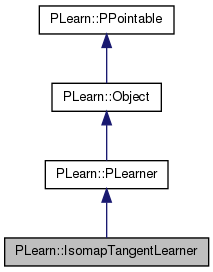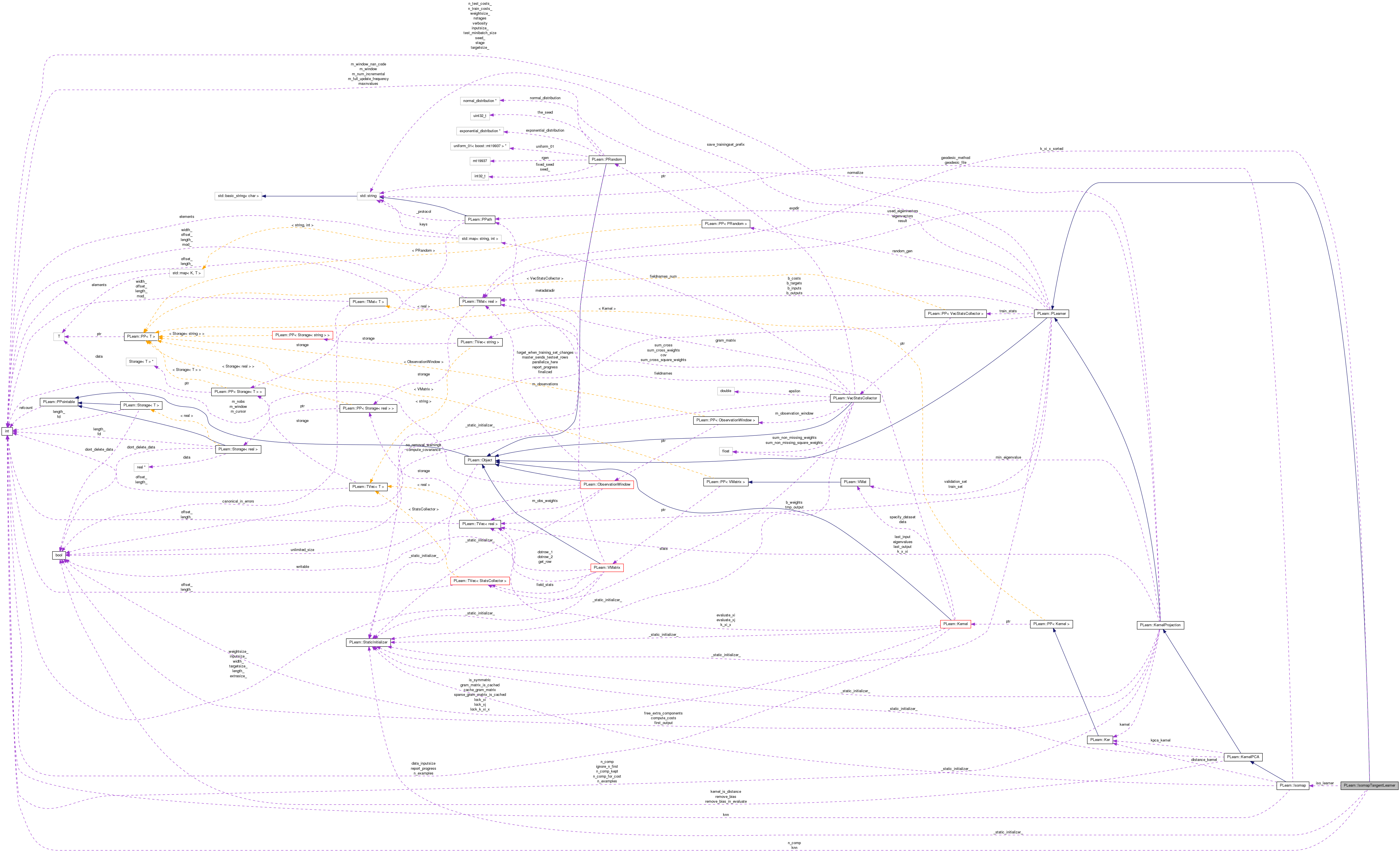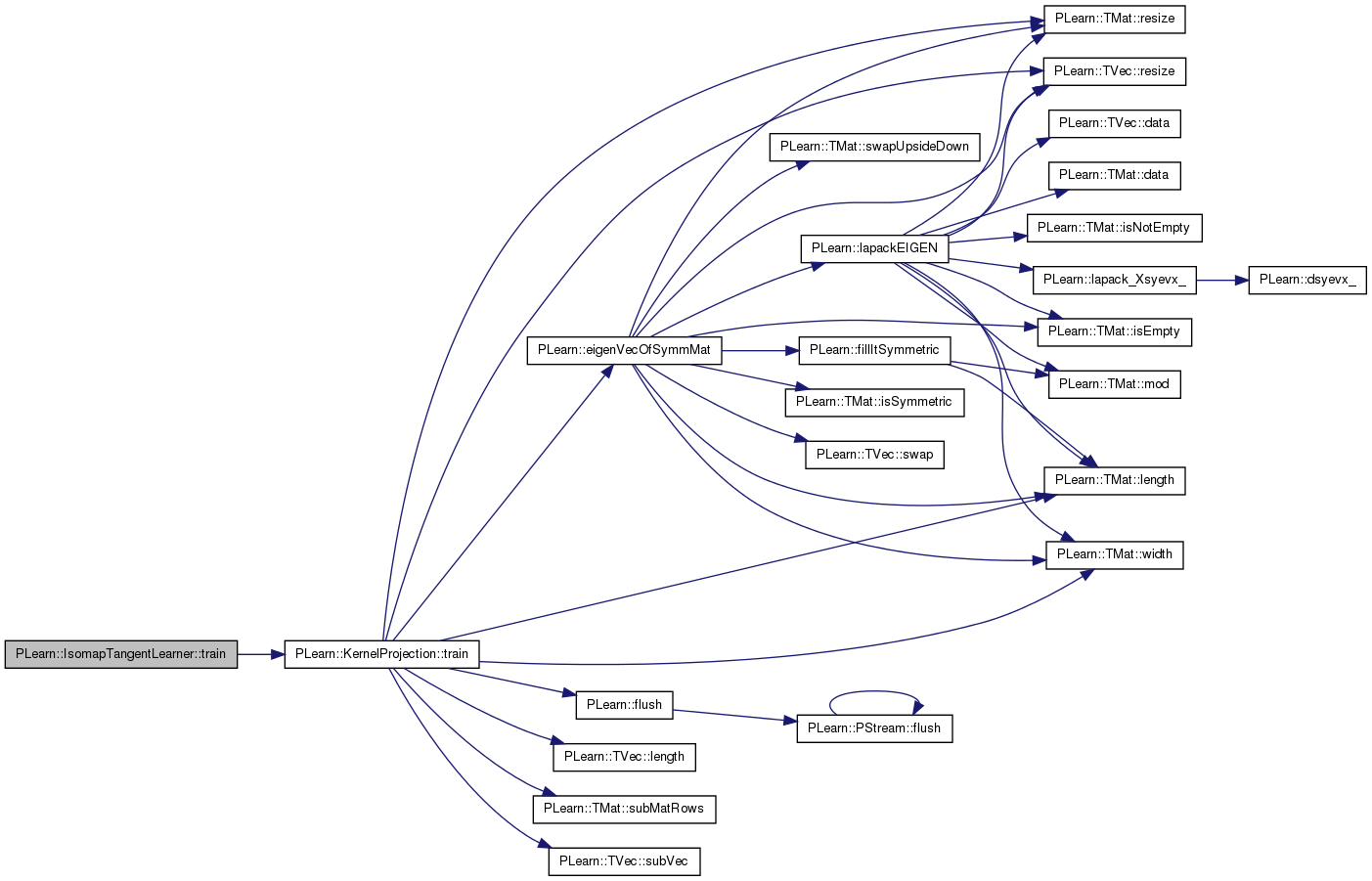|
PLearn 0.1
|
|
PLearn 0.1
|
#include <IsomapTangentLearner.h>


Public Member Functions | |
| IsomapTangentLearner () | |
| Default constructor. | |
| virtual void | build () |
| Simply calls inherited::build() then build_(). | |
| virtual void | makeDeepCopyFromShallowCopy (CopiesMap &copies) |
| Transforms a shallow copy into a deep copy. | |
| virtual string | classname () const |
| virtual OptionList & | getOptionList () const |
| virtual OptionMap & | getOptionMap () const |
| virtual RemoteMethodMap & | getRemoteMethodMap () const |
| virtual IsomapTangentLearner * | deepCopy (CopiesMap &copies) const |
| virtual int | outputsize () const |
| Returns the size of this learner's output, (which typically may depend on its inputsize(), targetsize() and set options). | |
| virtual void | forget () |
| (Re-)initializes the PLearner in its fresh state (that state may depend on the 'seed' option) And sets 'stage' back to 0 (this is the stage of a fresh learner!). | |
| virtual void | train () |
| The role of the train method is to bring the learner up to stage==nstages, updating the train_stats collector with training costs measured on-line in the process. | |
| virtual void | computeOutput (const Vec &input, Vec &output) const |
| Computes the output from the input. | |
| virtual void | computeCostsFromOutputs (const Vec &input, const Vec &output, const Vec &target, Vec &costs) const |
| Computes the costs from already computed output. | |
| virtual TVec< string > | getTestCostNames () const |
| Returns the names of the costs computed by computeCostsFromOutpus (and thus the test method). | |
| virtual TVec< string > | getTrainCostNames () const |
| Returns the names of the objective costs that the train method computes and for which it updates the VecStatsCollector train_stats. | |
Static Public Member Functions | |
| static string | _classname_ () |
| static OptionList & | _getOptionList_ () |
| static RemoteMethodMap & | _getRemoteMethodMap_ () |
| static Object * | _new_instance_for_typemap_ () |
| static bool | _isa_ (const Object *o) |
| static void | _static_initialize_ () |
| static const PPath & | declaringFile () |
Public Attributes | |
| int | n_comp |
| int | knn |
Static Public Attributes | |
| static StaticInitializer | _static_initializer_ |
Static Protected Member Functions | |
| static void | declareOptions (OptionList &ol) |
| Declares this class' options. | |
Protected Attributes | |
| Isomap | iso_learner |
| Mat | k_xi_x_sorted |
Private Types | |
| typedef PLearner | inherited |
Private Member Functions | |
| void | build_ () |
| This does the actual building. | |
Definition at line 53 of file IsomapTangentLearner.h.
typedef PLearner PLearn::IsomapTangentLearner::inherited [private] |
Reimplemented from PLearn::PLearner.
Definition at line 58 of file IsomapTangentLearner.h.
| PLearn::IsomapTangentLearner::IsomapTangentLearner | ( | ) |
Default constructor.
Definition at line 53 of file IsomapTangentLearner.cc.
| string PLearn::IsomapTangentLearner::_classname_ | ( | ) | [static] |
Reimplemented from PLearn::PLearner.
Definition at line 62 of file IsomapTangentLearner.cc.
| OptionList & PLearn::IsomapTangentLearner::_getOptionList_ | ( | ) | [static] |
Reimplemented from PLearn::PLearner.
Definition at line 62 of file IsomapTangentLearner.cc.
| RemoteMethodMap & PLearn::IsomapTangentLearner::_getRemoteMethodMap_ | ( | ) | [static] |
Reimplemented from PLearn::PLearner.
Definition at line 62 of file IsomapTangentLearner.cc.
Reimplemented from PLearn::PLearner.
Definition at line 62 of file IsomapTangentLearner.cc.
| Object * PLearn::IsomapTangentLearner::_new_instance_for_typemap_ | ( | ) | [static] |
Reimplemented from PLearn::Object.
Definition at line 62 of file IsomapTangentLearner.cc.
| StaticInitializer IsomapTangentLearner::_static_initializer_ & PLearn::IsomapTangentLearner::_static_initialize_ | ( | ) | [static] |
Reimplemented from PLearn::PLearner.
Definition at line 62 of file IsomapTangentLearner.cc.
| void PLearn::IsomapTangentLearner::build | ( | ) | [virtual] |
Simply calls inherited::build() then build_().
Reimplemented from PLearn::PLearner.
Definition at line 111 of file IsomapTangentLearner.cc.
References PLearn::PLearner::build(), and build_().
{
inherited::build();
build_();
}

| void PLearn::IsomapTangentLearner::build_ | ( | ) | [private] |
This does the actual building.
Reimplemented from PLearn::PLearner.
Definition at line 84 of file IsomapTangentLearner.cc.
References PLearn::Isomap::build(), iso_learner, knn, PLearn::Isomap::knn, n_comp, PLearn::KernelProjection::n_comp, PLearn::KernelProjection::setTrainingSet(), and PLearn::PLearner::train_set.
Referenced by build().
{
// ### This method should do the real building of the object,
// ### according to set 'options', in *any* situation.
// ### Typical situations include:
// ### - Initial building of an object from a few user-specified options
// ### - Building of a "reloaded" object: i.e. from the complete set of all serialised options.
// ### - Updating or "re-building" of an object after a few "tuning" options have been modified.
// ### You should assume that the parent class' build_() has already been called.
iso_learner.knn = knn;
iso_learner.n_comp = n_comp;
if (train_set)
iso_learner.setTrainingSet(train_set);
iso_learner.build();
// peut etre qu'il faut un VectatsCollector
// PP<VecStatsCollector> train_stats = new VecStatsCollector();
// learner->setTrainStatsCollector(train_stats);
// learner->setTrainingSet(trainset);
// learner->train();
}


| string PLearn::IsomapTangentLearner::classname | ( | ) | const [virtual] |
Reimplemented from PLearn::Object.
Definition at line 62 of file IsomapTangentLearner.cc.
| void PLearn::IsomapTangentLearner::computeCostsFromOutputs | ( | const Vec & | input, |
| const Vec & | output, | ||
| const Vec & | target, | ||
| Vec & | costs | ||
| ) | const [virtual] |
Computes the costs from already computed output.
Implements PLearn::PLearner.
Definition at line 271 of file IsomapTangentLearner.cc.
{
// Compute the costs from *already* computed output.
// ...
}
| void PLearn::IsomapTangentLearner::computeOutput | ( | const Vec & | input, |
| Vec & | output | ||
| ) | const [virtual] |
Computes the output from the input.
Reimplemented from PLearn::PLearner.
Definition at line 162 of file IsomapTangentLearner.cc.
References PLearn::KernelProjection::eigenvectors, i, PLearn::PLearner::inputsize(), iso_learner, j, k_xi_x_sorted, PLearn::KernelProjection::kernel, knn, PLearn::VMat::length(), PLearn::TMat< T >::length(), n_comp, PLearn::PLearner::n_examples, PLearn::norm(), PLearn::TMat< T >::subMatRows(), and PLearn::TMat< T >::toVec().
{
// Compute the output from the input.
// int nout = outputsize();
// output.resize(nout);
// ...
// ici je recupere le GeodesicDistanceKernel
PP<AdditiveNormalizationKernel> ank = dynamic_cast<AdditiveNormalizationKernel*>((Kernel*)iso_learner.kernel);
PP<GeodesicDistanceKernel> gdk = dynamic_cast<GeodesicDistanceKernel*>((Kernel*)ank->source_kernel);
// output.resize(outputsize());
Mat k_xi_x;
//cout<<input<<endl;
// on fait un knn+1 au cas ou on elve la premiere ligne un peu plus loin
gdk->distance_kernel->computeNearestNeighbors(input, k_xi_x, knn+1);
Mat k_xi_x_sorted;
// we assume that the trainingset contains each exemple only one time
// here we manage the case of computing tangent plane on a point of the training set
if (k_xi_x(0,0) < 1e-9)
k_xi_x_sorted = k_xi_x.subMatRows(1,k_xi_x.length() - 1);
else
k_xi_x_sorted = k_xi_x;
//cout<<k_xi_x.subMatRows(1,knn);
Mat result(n_comp,inputsize());
Vec dkdx(inputsize()); //dk/dx
Vec temp(inputsize());
Vec term2(inputsize());
Vec term1(inputsize());
// Vec tangentVector(inputsize()); // = sum_i v_ik*dk(i)/dx
int ngn;
VMat trainset = ank->specify_dataset;
int n_examples = trainset->length();
Mat diK_dx(n_examples,inputsize());
int i,j,nc;
real D;
term1<<0;
// real seuil = 1e-9;
for(j=0;j<n_examples;++j)
{
ngn = gdk->computeNearestGeodesicNeighbour(j, k_xi_x_sorted);// ngn minimise la distance geodesique entre input et j
trainset->getRow(ngn,temp);
temp << (input-temp);
D = norm(temp) + gdk->geo_distances->get(j,ngn);
// cout<<D<<endl;
// probleme resolu: il faut appeler gdk->distance_kernel->compute...
// cout<<" "<<D*D<<" "<<gdk->evaluate_i_x_from_distances(j,k_xi_x_sorted) <<endl;
//if (norm(temp) > seuil)
term1 += D*(temp)/norm(temp);
}
term1/=n_examples;
for(i=0;i<n_examples;++i)
{
// get the nearest neighbor
ngn = gdk->computeNearestGeodesicNeighbour(i, k_xi_x_sorted); // ngn minimise la distance geodesique entre input et i
trainset->getRow(ngn,temp);
//cout<<i<<"="<<ngn<<"-"<<int(k_xi_x_sorted(ngn,1))<<" ";
temp << (input-temp); // temp = x-xN
// cout<<gdk->evaluate_i_x(i,input,k_xi_x_sorted);
// cout<<norm(temp)<<endl;
term2<<0;
D = norm(temp) + gdk->geo_distances->get(i,ngn);
//if (norm(temp) > seuil)
term2 = D*(temp)/norm(temp);
// else
// term2.fill(0);
//cout<<term2<<endl;
//cout<<sum;
diK_dx(i) << (term1 - term2); // exactement la formule de NIPS
//cout<<diK_dx(i);
}
for(nc=0;nc<n_comp;++nc)
{
// compute the corresponding vector with the Nystrom formula
// d ek / dx = 1/n sum_i dK/dX
// initialisation
temp<<(0);
for(i=0;i<n_examples;++i)
{
temp += (iso_learner.eigenvectors(nc,i) * diK_dx(i));
}
// on ne normalise pas car c'est la direction vecteur qui nous interesse et pas sa norme
// en plus on normalise tout a 1 dans matlab pour eviter les erreurs numériques.
// result(nc)<<(temp/iso_learner.eigenvalues[nc]);
result(nc)<<(temp);
}
//cout<<result;
// toVec: a mettre dans l'aide
output << result.toVec();
}

| void PLearn::IsomapTangentLearner::declareOptions | ( | OptionList & | ol | ) | [static, protected] |
Declares this class' options.
Reimplemented from PLearn::PLearner.
Definition at line 64 of file IsomapTangentLearner.cc.
References PLearn::OptionBase::buildoption, PLearn::declareOption(), PLearn::PLearner::declareOptions(), iso_learner, knn, PLearn::OptionBase::learntoption, and n_comp.
{
// ### Declare all of this object's options here
// ### For the "flags" of each option, you should typically specify
// ### one of OptionBase::buildoption, OptionBase::learntoption or
// ### OptionBase::tuningoption. Another possible flag to be combined with
// ### is OptionBase::nosave
declareOption(ol, "knn", &IsomapTangentLearner::knn, OptionBase::buildoption,
"Number of nearest neighbor taken into account");
declareOption(ol, "n_comp", &IsomapTangentLearner::n_comp, OptionBase::buildoption,
"Number of Components");
declareOption(ol, "iso_learner", &IsomapTangentLearner::iso_learner, OptionBase::learntoption,
"The Isomap Learner");
// Now call the parent class' declareOptions
inherited::declareOptions(ol);
}

| static const PPath& PLearn::IsomapTangentLearner::declaringFile | ( | ) | [inline, static] |
Reimplemented from PLearn::PLearner.
Definition at line 124 of file IsomapTangentLearner.h.
| IsomapTangentLearner * PLearn::IsomapTangentLearner::deepCopy | ( | CopiesMap & | copies | ) | const [virtual] |
Reimplemented from PLearn::PLearner.
Definition at line 62 of file IsomapTangentLearner.cc.
| void PLearn::IsomapTangentLearner::forget | ( | ) | [virtual] |
(Re-)initializes the PLearner in its fresh state (that state may depend on the 'seed' option) And sets 'stage' back to 0 (this is the stage of a fresh learner!).
(Re-)initialize the PLearner in its fresh state (that state may depend on the 'seed' option) And sets 'stage' back to 0 (this is the stage of a fresh learner!)
A typical forget() method should do the following:
Reimplemented from PLearn::PLearner.
Definition at line 140 of file IsomapTangentLearner.cc.
{
}
| OptionList & PLearn::IsomapTangentLearner::getOptionList | ( | ) | const [virtual] |
Reimplemented from PLearn::Object.
Definition at line 62 of file IsomapTangentLearner.cc.
| OptionMap & PLearn::IsomapTangentLearner::getOptionMap | ( | ) | const [virtual] |
Reimplemented from PLearn::Object.
Definition at line 62 of file IsomapTangentLearner.cc.
| RemoteMethodMap & PLearn::IsomapTangentLearner::getRemoteMethodMap | ( | ) | const [virtual] |
Reimplemented from PLearn::Object.
Definition at line 62 of file IsomapTangentLearner.cc.
| TVec< string > PLearn::IsomapTangentLearner::getTestCostNames | ( | ) | const [virtual] |
Returns the names of the costs computed by computeCostsFromOutpus (and thus the test method).
Implements PLearn::PLearner.
Definition at line 278 of file IsomapTangentLearner.cc.
{
// Return the names of the costs computed by computeCostsFromOutpus
// (these may or may not be exactly the same as what's returned by getTrainCostNames).
// ...
return TVec<string>();
}
| TVec< string > PLearn::IsomapTangentLearner::getTrainCostNames | ( | ) | const [virtual] |
Returns the names of the objective costs that the train method computes and for which it updates the VecStatsCollector train_stats.
Implements PLearn::PLearner.
Definition at line 286 of file IsomapTangentLearner.cc.
{
// Return the names of the objective costs that the train method computes and
// for which it updates the VecStatsCollector train_stats
// (these may or may not be exactly the same as what's returned by getTestCostNames).
// ...
return TVec<string>();
}
| void PLearn::IsomapTangentLearner::makeDeepCopyFromShallowCopy | ( | CopiesMap & | copies | ) | [virtual] |
Transforms a shallow copy into a deep copy.
Reimplemented from PLearn::PLearner.
Definition at line 118 of file IsomapTangentLearner.cc.
References PLearn::PLearner::makeDeepCopyFromShallowCopy(), and PLERROR.
{
inherited::makeDeepCopyFromShallowCopy(copies);
// ### Call deepCopyField on all "pointer-like" fields
// ### that you wish to be deepCopied rather than
// ### shallow-copied.
// ### ex:
// deepCopyField(trainvec, copies);
// ### Remove this line when you have fully implemented this method.
PLERROR("IsomapTangentLearner::makeDeepCopyFromShallowCopy not fully (correctly) implemented yet!");
}

| int PLearn::IsomapTangentLearner::outputsize | ( | ) | const [virtual] |
Returns the size of this learner's output, (which typically may depend on its inputsize(), targetsize() and set options).
Implements PLearn::PLearner.
Definition at line 133 of file IsomapTangentLearner.cc.
References PLearn::PLearner::inputsize(), and n_comp.
{
// Compute and return the size of this learner's output (which typically
// may depend on its inputsize(), targetsize() and set options).
return inputsize()*n_comp;
}

| void PLearn::IsomapTangentLearner::train | ( | ) | [virtual] |
The role of the train method is to bring the learner up to stage==nstages, updating the train_stats collector with training costs measured on-line in the process.
Implements PLearn::PLearner.
Definition at line 152 of file IsomapTangentLearner.cc.
References iso_learner, and PLearn::KernelProjection::train().
{
// The role of the train method is to bring the learner up to stage==nstages,
// updating train_stats with training costs measured on-line in the process.
iso_learner.train();
}

Reimplemented from PLearn::PLearner.
Definition at line 124 of file IsomapTangentLearner.h.
Isomap PLearn::IsomapTangentLearner::iso_learner [protected] |
Definition at line 68 of file IsomapTangentLearner.h.
Referenced by build_(), computeOutput(), declareOptions(), and train().
Mat PLearn::IsomapTangentLearner::k_xi_x_sorted [protected] |
Definition at line 69 of file IsomapTangentLearner.h.
Referenced by computeOutput().
Definition at line 74 of file IsomapTangentLearner.h.
Referenced by build_(), computeOutput(), and declareOptions().
Definition at line 73 of file IsomapTangentLearner.h.
Referenced by build_(), computeOutput(), declareOptions(), and outputsize().
 1.7.4
1.7.4